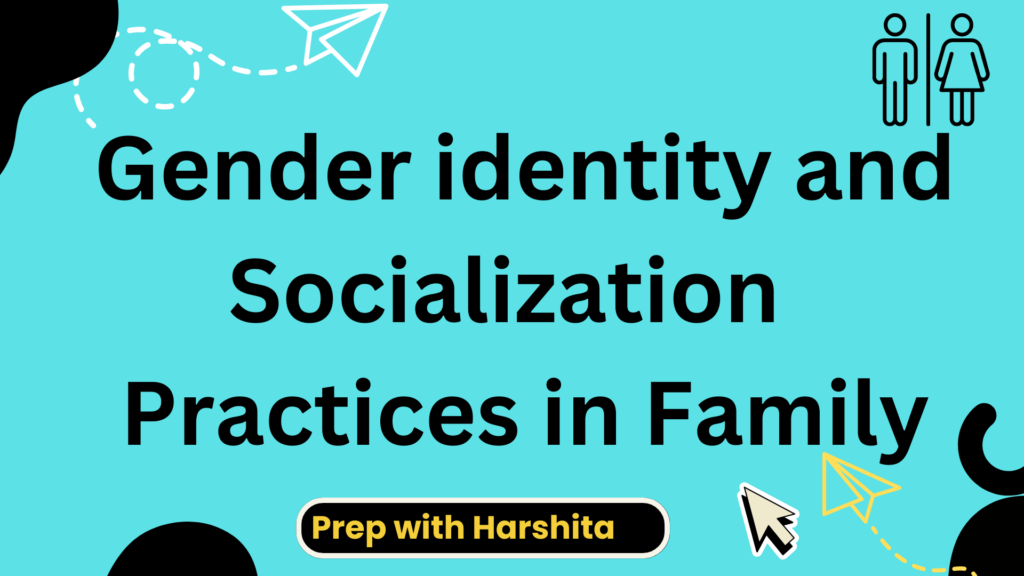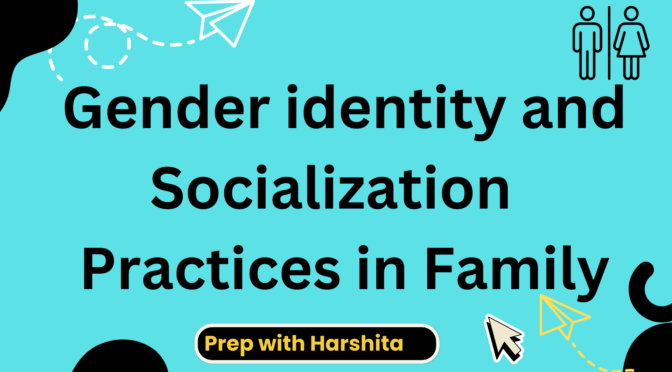Gender identities and socialization practices within the family are deeply intertwined and play a significant role in shaping individuals’ understanding of themselves and their roles in society.
Let’s explore this topic in more detail:
- Gender Identities: Gender identity refers to an individual’s internal sense of their own gender, which may be different from their assigned sex at birth. While many people identify with the gender they were assigned at birth (cisgender), others may identify as transgender, non-binary, genderqueer, or with other diverse gender identities.
- Socialization Practices: Socialization is the process through which individuals learn and internalize societal norms, values, and behaviors. Family is one of the primary agents of socialization, where children acquire knowledge and expectations about gender roles and behaviors.
Socialization practices related to gender can include the following:
a. Gendered Roles and Expectations: Families often socialize children into gendered roles and expectations. This can involve assigning different tasks, responsibilities, and privileges based on gender. For example, girls may be encouraged to engage in activities associated with nurturing and domesticity, while boys may be encouraged to be independent and assertive.
b. Gendered Toys and Activities: Families often provide children with toys, games, and activities that align with traditional gender roles. Girls are often given dolls, kitchen sets, and dress-up items, while boys are given action figures, building blocks, and sports equipment. These choices can reinforce gender stereotypes and limit children’s exploration of diverse interests.
c. Language and Communication: Families use language and communication patterns that can reinforce gender norms. For instance, girls may be praised for being “pretty” or “sweet,” while boys may be encouraged to be “strong” or “brave.” Parents and caregivers may also use gendered pronouns and labels when referring to children or discussing their abilities and future aspirations.
d. Role Modeling: Parents and family members serve as role models for children’s gender behaviors and attitudes. Children observe and imitate the behaviors they see from their parents, siblings, and other family members. For instance, a child may learn about gender roles by observing how their parents divide household chores or engage in caregiving activities.
e. Reinforcement and Punishment: Families often reinforce or discourage certain gendered behaviors through rewards and punishments. For example, a girl who expresses interest in traditionally male-dominated activities may face disapproval or even punishment, while a boy who conforms to societal expectations may receive praise or rewards. - Impacts and Consequences: Gender socialization within the family can have lasting impacts on individuals. It shapes their self-perception, sense of identity, and understanding of acceptable behavior.
Some potential impacts include:
a. Gender Stereotyping: Socialization practices can reinforce gender stereotypes and limit individuals’ freedom to explore diverse interests and expressions. This can perpetuate inequality and restrict opportunities for personal growth and self-fulfillment.
b. Gender Role Expectations: Socialization can instill rigid expectations about gender roles, limiting individuals’ choices and creating pressure to conform. This can affect career choices, family dynamics, and overall life satisfaction.
c. Gender Inequality: Socialization practices that prioritize certain gender roles and behaviors can contribute to gender inequality. For example, when girls are socialized to prioritize nurturing and caregiving, they may face barriers in pursuing careers or leadership positions.
d. Trans and Non-Binary Experiences: In families where gender identities diverge from societal norms, socialization practices can have unique challenges. Transgender and non-binary individuals may face rejection, misunderstanding, or lack of support, leading to strained family relationships.
It’s important to note that socialization practices vary across cultures, and there is increasing recognition of the need for more inclusive and egalitarian approaches.
Also Read: Gender Stereotyping

Also visit: Prep with Harshita


It’s a pity you don’t have a donate button! I’d certainly donate to this excellent blog! I guess for now i’ll settle for bookmarking and adding your RSS feed to my Google account. I look forward to brand new updates and will talk about this site with my Facebook group. Chat soon!
Thanks for sharing. I read many of your blog posts, cool, your blog is very good.
50 Price reduction Pertaining to All Private Proxies! Top-notch superior, Indefinite bandwith, 1000 mb/s superspeed, 99,9 uptime, Not successive IP’s, Virtually no usage limits, Several subnets, USA as well as Europe proxies – Acquire Right now – https://DreamProxies.com
equilibrado estatico
Equipos de balanceo: importante para el desempeño uniforme y productivo de las dispositivos.
En el entorno de la ciencia contemporánea, donde la efectividad y la seguridad del equipo son de gran trascendencia, los equipos de ajuste desempeñan un función fundamental. Estos equipos dedicados están diseñados para equilibrar y estabilizar elementos giratorias, ya sea en equipamiento productiva, medios de transporte de desplazamiento o incluso en electrodomésticos hogareños.
Para los especialistas en mantenimiento de equipos y los profesionales, manejar con aparatos de equilibrado es crucial para promover el funcionamiento uniforme y seguro de cualquier dispositivo giratorio. Gracias a estas alternativas innovadoras modernas, es posible minimizar sustancialmente las vibraciones, el sonido y la carga sobre los soportes, aumentando la tiempo de servicio de partes valiosos.
De igual manera trascendental es el papel que desempeñan los sistemas de balanceo en la asistencia al cliente. El apoyo técnico y el soporte permanente aplicando estos equipos posibilitan dar servicios de excelente excelencia, aumentando la contento de los consumidores.
Para los titulares de empresas, la inversión en sistemas de calibración y sensores puede ser importante para incrementar la productividad y eficiencia de sus equipos. Esto es principalmente importante para los dueños de negocios que administran reducidas y pequeñas negocios, donde cada aspecto vale.
Por otro lado, los aparatos de ajuste tienen una gran aplicación en el campo de la protección y el gestión de excelencia. Posibilitan identificar probables defectos, reduciendo reparaciones costosas y problemas a los dispositivos. También, los indicadores generados de estos equipos pueden aplicarse para mejorar métodos y potenciar la exposición en plataformas de búsqueda.
Las áreas de implementación de los equipos de balanceo abarcan diversas ramas, desde la elaboración de ciclos hasta el supervisión del medio ambiente. No influye si se considera de importantes elaboraciones de fábrica o modestos talleres de uso personal, los equipos de calibración son esenciales para asegurar un desempeño productivo y libre de paradas.
мост бет мост бет .
Norma ISO 10816
Dispositivos de ajuste: fundamental para el desempeno fluido y productivo de las maquinas.
En el mundo de la tecnologia contemporanea, donde la eficiencia y la seguridad del aparato son de maxima significancia, los aparatos de calibracion cumplen un funcion vital. Estos aparatos dedicados estan concebidos para ajustar y estabilizar componentes giratorias, ya sea en maquinaria productiva, vehiculos de traslado o incluso en electrodomesticos hogarenos.
Para los especialistas en soporte de aparatos y los profesionales, manejar con equipos de equilibrado es importante para proteger el operacion fluido y seguro de cualquier sistema dinamico. Gracias a estas alternativas modernas sofisticadas, es posible limitar considerablemente las sacudidas, el ruido y la esfuerzo sobre los sujeciones, mejorando la duracion de elementos costosos.
Tambien relevante es el rol que cumplen los sistemas de ajuste en la soporte al usuario. El ayuda profesional y el soporte continuo utilizando estos sistemas permiten proporcionar asistencias de gran calidad, incrementando la satisfaccion de los clientes.
Para los titulares de empresas, la financiamiento en sistemas de equilibrado y sensores puede ser importante para incrementar la eficiencia y productividad de sus equipos. Esto es particularmente significativo para los emprendedores que gestionan reducidas y pequenas negocios, donde cada elemento es relevante.
Tambien, los dispositivos de ajuste tienen una extensa implementacion en el campo de la seguridad y el monitoreo de excelencia. Facilitan identificar posibles defectos, reduciendo reparaciones costosas y averias a los dispositivos. Incluso, los indicadores generados de estos sistemas pueden usarse para maximizar procedimientos y mejorar la presencia en plataformas de investigacion.
Las zonas de utilizacion de los equipos de calibracion incluyen variadas ramas, desde la manufactura de transporte personal hasta el monitoreo de la naturaleza. No afecta si se trata de grandes producciones manufactureras o modestos establecimientos hogarenos, los dispositivos de ajuste son indispensables para asegurar un rendimiento efectivo y sin interrupciones.
[b]Eliminate Vibration Issues and Improve Equipment Performance[/b]
Vibration is a silent killer of industrial machines. Imbalance leads to worn-out bearings, misalignment, and costly breakdowns. [b]Balanset-1A[/b] is the ultimate tool for detecting and correcting vibration problems in electric motors, pumps, and turbines.
[b]What Makes Balanset-1A Stand Out?[/b]
– Precise vibration measurement & balancing
– Compact, lightweight, and easy to use
– Two kit options:
[url=https://www.amazon.es/dp/B0DCT5CCKT]Full Kit on Amazon[/url] – Advanced sensors & accessories, Software for real-time data analysis, Hard carrying case
Price: [b]2250 EUR[/b]
[url=https://www.amazon.es/dp/B0DCT5CCKT][img]https://i.postimg.cc/SXSZy3PV/4.jpg[/img][/url]
[url=https://www.amazon.es/dp/B0DCT4P7JR]OEM Kit on Amazon[/url] – Includes core balancing components, Same high-quality device
Price: [b]1978 EUR[/b]
[url=https://www.amazon.es/dp/B0DCT4P7JR][img]https://i.postimg.cc/cvM9G0Fr/2.jpg[/img][/url]
Prevent unexpected breakdowns – Invest in [b]Balanset-1A[/b] today!
Great ?I should certainly pronounce, impressed with your website. I had no trouble navigating through all the tabs and related info ended up being truly easy to do to access. I recently found what I hoped for before you know it at all. Reasonably unusual. Is likely to appreciate it for those who add forums or something, web site theme . a tones way for your customer to communicate. Nice task..